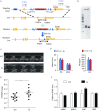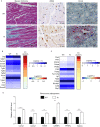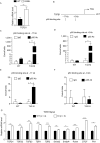TMEM43-S358L mutation enhances NF-κB-TGFβ signal cascade in arrhythmogenic right ventricular dysplasia/cardiomyopathy
- PMID: 29980933
- PMCID: PMC6340891
- DOI: 10.1007/s13238-018-0563-2
TMEM43-S358L mutation enhances NF-κB-TGFβ signal cascade in arrhythmogenic right ventricular dysplasia/cardiomyopathy
Abstract
Arrhythmogenic right ventricular dysplasia/cardiomyopathy (ARVD/C) is a genetic cardiac muscle disease that accounts for approximately 30% sudden cardiac death in young adults. The Ser358Leu mutation of transmembrane protein 43 (TMEM43) was commonly identified in the patients of highly lethal and fully penetrant ARVD subtype, ARVD5. Here, we generated TMEM43 S358L mouse to explore the underlying mechanism. This mouse strain showed the classic pathologies of ARVD patients, including structural abnormalities and cardiac fibrofatty. TMEM43 S358L mutation led to hyper-activated nuclear factor κB (NF-κB) activation in heart tissues and primary cardiomyocyte cells. Importantly, this hyper activation of NF-κB directly drove the expression of pro-fibrotic gene, transforming growth factor beta (TGFβ1), and enhanced downstream signal, indicating that TMEM43 S358L mutation up-regulates NF-κB-TGFβ signal cascade during ARVD cardiac fibrosis. Our study partially reveals the regulatory mechanism of ARVD development.
Keywords: ARVD; NF-κB; TGFβ; TMEM43; fibrosis; knock-in mouse.
Figures






Similar articles
-
Severe Cardiac Dysfunction and Death Caused by Arrhythmogenic Right Ventricular Cardiomyopathy Type 5 Are Improved by Inhibition of Glycogen Synthase Kinase-3β.Circulation. 2019 Oct;140(14):1188-1204. doi: 10.1161/CIRCULATIONAHA.119.040366. Epub 2019 Sep 5. Circulation. 2019. PMID: 31567019 Free PMC article.
-
Overexpression of Wild-Type TMEM43 Improves Cardiac Function in Arrhythmogenic Right Ventricular Cardiomyopathy Type 5.Circ Res. 2025 Apr 11;136(8):830-844. doi: 10.1161/CIRCRESAHA.124.325848. Epub 2025 Mar 17. Circ Res. 2025. PMID: 40091736 Free PMC article.
-
The TMEM43 S358L mutation affects cardiac, small intestine, and metabolic homeostasis in a knock-in mouse model.Am J Physiol Heart Circ Physiol. 2023 Jun 1;324(6):H866-H880. doi: 10.1152/ajpheart.00712.2022. Epub 2023 Apr 21. Am J Physiol Heart Circ Physiol. 2023. PMID: 37083466 Free PMC article.
-
Transmembrane Protein 43: Molecular and Pathogenetic Implications in Arrhythmogenic Cardiomyopathy and Various Other Diseases.Int J Mol Sci. 2025 Jul 17;26(14):6856. doi: 10.3390/ijms26146856. Int J Mol Sci. 2025. PMID: 40725103 Free PMC article. Review.
-
Arrythmogenic right ventricular dysplasia/cardiomyopathy (ARVD/C) and cathecholaminergic polymorphic ventricular tachycardia (CPVT): A phenotypic spectrum seen in same patient.J Electrocardiol. 2015 Sep-Oct;48(5):874-8. doi: 10.1016/j.jelectrocard.2015.06.005. Epub 2015 Jun 7. J Electrocardiol. 2015. PMID: 26082335 Review.
Cited by
-
Inflammation in the Pathogenesis of Arrhythmogenic Cardiomyopathy: Secondary Event or Active Driver?Front Cardiovasc Med. 2021 Dec 20;8:784715. doi: 10.3389/fcvm.2021.784715. eCollection 2021. Front Cardiovasc Med. 2021. PMID: 34988129 Free PMC article. Review.
-
New avenues for systematically inferring cell-cell communication: through single-cell transcriptomics data.Protein Cell. 2020 Dec;11(12):866-880. doi: 10.1007/s13238-020-00727-5. Epub 2020 May 21. Protein Cell. 2020. PMID: 32435978 Free PMC article. Review.
-
Cardiomyopathies in China: A 2018-2019 state-of-the-art review.Chronic Dis Transl Med. 2020 Jul 5;6(4):224-238. doi: 10.1016/j.cdtm.2020.05.006. eCollection 2020 Dec. Chronic Dis Transl Med. 2020. PMID: 33336168 Free PMC article. Review.
-
Arrhythmogenic Right Ventricular Cardiomyopathy: A Comprehensive Review.J Cardiovasc Dev Dis. 2025 Feb 13;12(2):71. doi: 10.3390/jcdd12020071. J Cardiovasc Dev Dis. 2025. PMID: 39997505 Free PMC article. Review.
-
Systems genetics analysis defines importance of TMEM43/LUMA for cardiac- and metabolic-related pathways.Physiol Genomics. 2022 Jan 1;54(1):22-35. doi: 10.1152/physiolgenomics.00066.2021. Epub 2021 Nov 12. Physiol Genomics. 2022. PMID: 34766515 Free PMC article.
References
-
- Asimaki A, Tandri H, Duffy ER, Winterfield JR, Mackey-Bojack S, Picken MM, Cooper LT, Wilber DJ, Marcus FI, Basso C, et al. Altered desmosomal proteins in granulomatous myocarditis and potential pathogenic links to arrhythmogenic right ventricular cardiomyopathy. Circ Arrhythm Electrophysiol. 2011;4:743–752. doi: 10.1161/CIRCEP.111.964890. - DOI - PMC - PubMed
Publication types
MeSH terms
Substances
LinkOut - more resources
Full Text Sources
Other Literature Sources
Molecular Biology Databases
Miscellaneous

